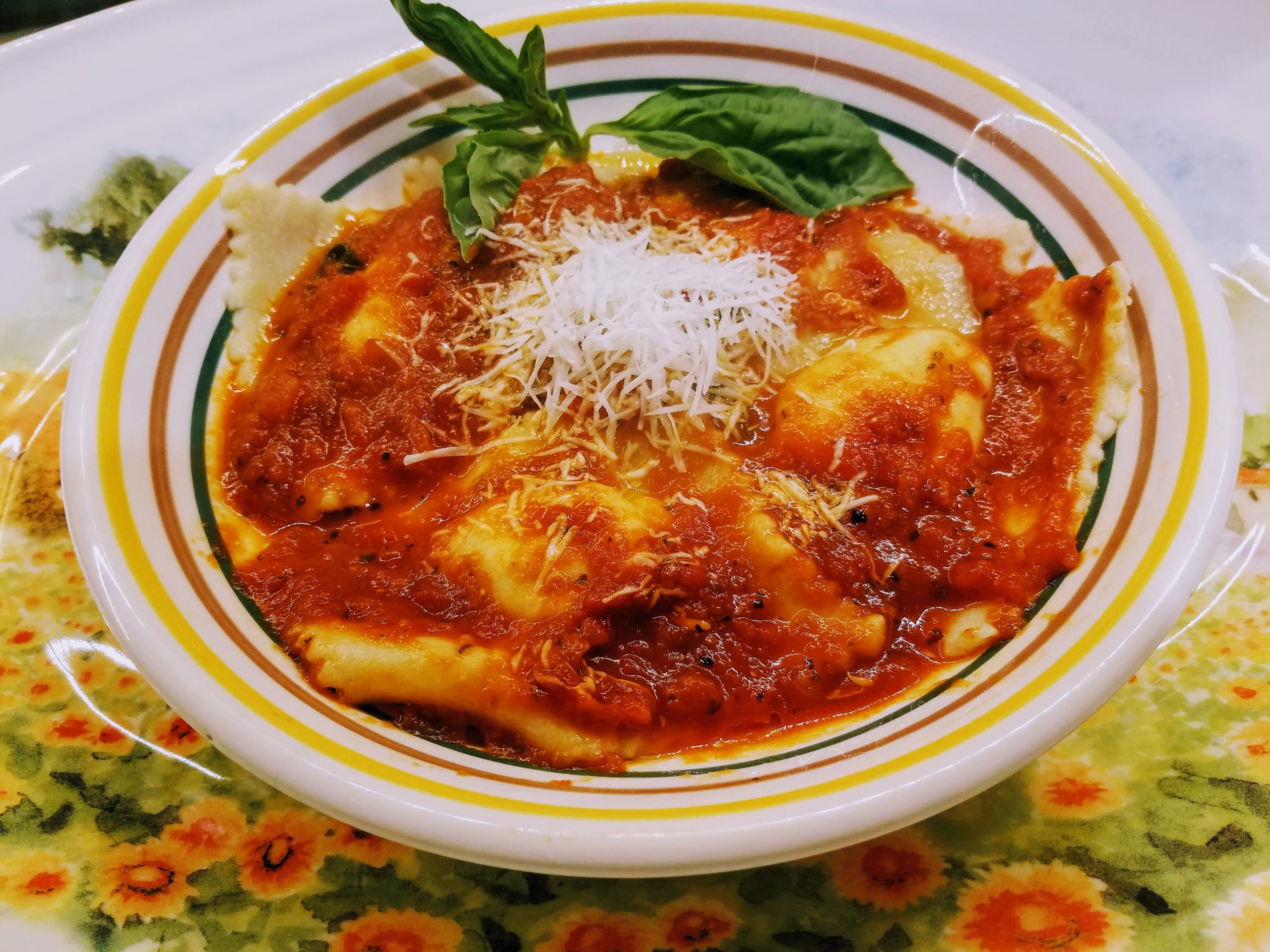
Gluten Free Three Cheeses Ravioli
Equipment
- Rolling Pin
- Pasta Machine optional
Ingredients
- 1 Gluten Free Sourdough Pasta Recipe see below
Three Cheeses Filling for Ravioli
- 1 egg
- 1 cup mozzarella cheese
- 8 – 10 ounces whole milk ricotta
- 1/3 cup Pecorino Romano Cheese
- 1 – 2 cloves garlic crushed
- 3/8 teaspoon black pepper freshly ground
- 3/8 teaspoon salt
- 1 tablespoon flat leaf parsley chopped
- 1/4 cup Gluten free 1 to 1 flour
- 1/4 cup finely ground cornmeal, gf combined together, for rolling out the pasta sheets
- Egg wash of 1 tablespoon egg white and 1 tablespoon water beaten together with a fork
Marinara Sauce
- 2 tablespoons olive oil extra virgin
- 1/2 small onion minced very small
- 1/4 teaspoon salt
- 4 cloves garlic
- 1 28 oz. can crushed tomatoes with salt
- 1 3/4 cups water
- 1 1/2 teaspoons dried basil crushed, gluten free
- 10 large fresh basil leaves torn
Instructions
Three Cheeses Filling for Ravioli
- Stir together all the ingredients in a small bowl and refrigerate for a minimum of 4 hours or overnight.
Marinara Sauce
- Heat a saucepan with the olive oil. Sauté the onion with the salt until soft, then add garlic and quickly stir. Add the tomatoes, water and dried basil and simmer, covered with lid cracked, over low heat for 1 hour. Add fresh basil and continue simmering for another 1/2 – 1 hour, stirring often.
Gluten Free Sourdough Ravioli with Three Cheeses
- Remove the pasta from the refrigerator (after letting sit for 6- 8 hours or overnight). Bring to room temperature for 15 – 20 minutes. Cover a large board with a combination of gluten free 1 to 1 flour and finely ground cornmeal. Put more of each flour into a small ramekin to add more to the board as needed.
- Remove the filling from the refrigerator. Take one section of dough and flatten a little. Cover with a piece of parchment and roll out to 1/8 inch or just over (about 5 inches wide). Cut in half lengthwise, making two equal length strips. Feed one strip carefully through the pasta maker, set on the largest setting. Move down a notch and feed through again, carefully passing the pasta through until you have moved the notch down to the 3rd or 4th smallest setting. The dough sheet may tear if you go smaller than this, but you do want to make the sheets as thin as you can. Set the sheet aside and proceed to the next sheet. When you have two sheets of equal sizes, lay one sheet next to the other on the board.
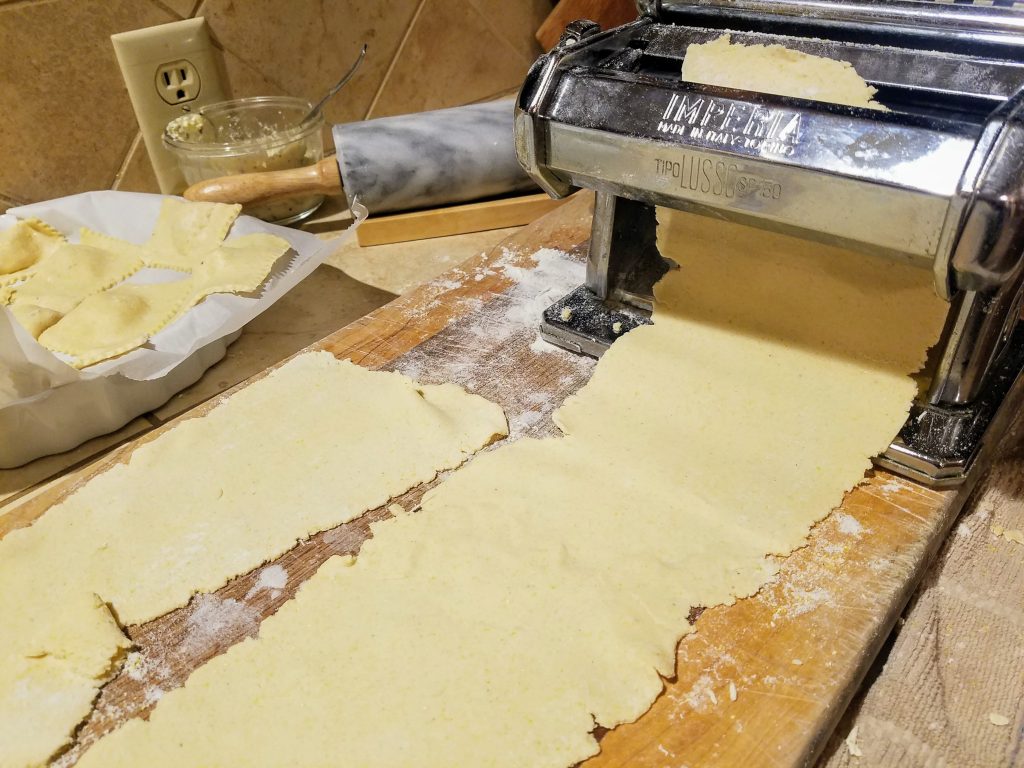
- For the fold over – There are two ways to proceed. Method 1: You can use one sheet of 4 1/2″ or 5″ wide and spoon one teaspoon unto the dough at roughly the 3 – 3 1/2 inch width (marked horizontally) and every 1 1/2 – 2 inches across the dough piece, vertically. You can cut the edge of the dough making a smooth line or leave it as this will be cut off with your ravioli edger/sealer.
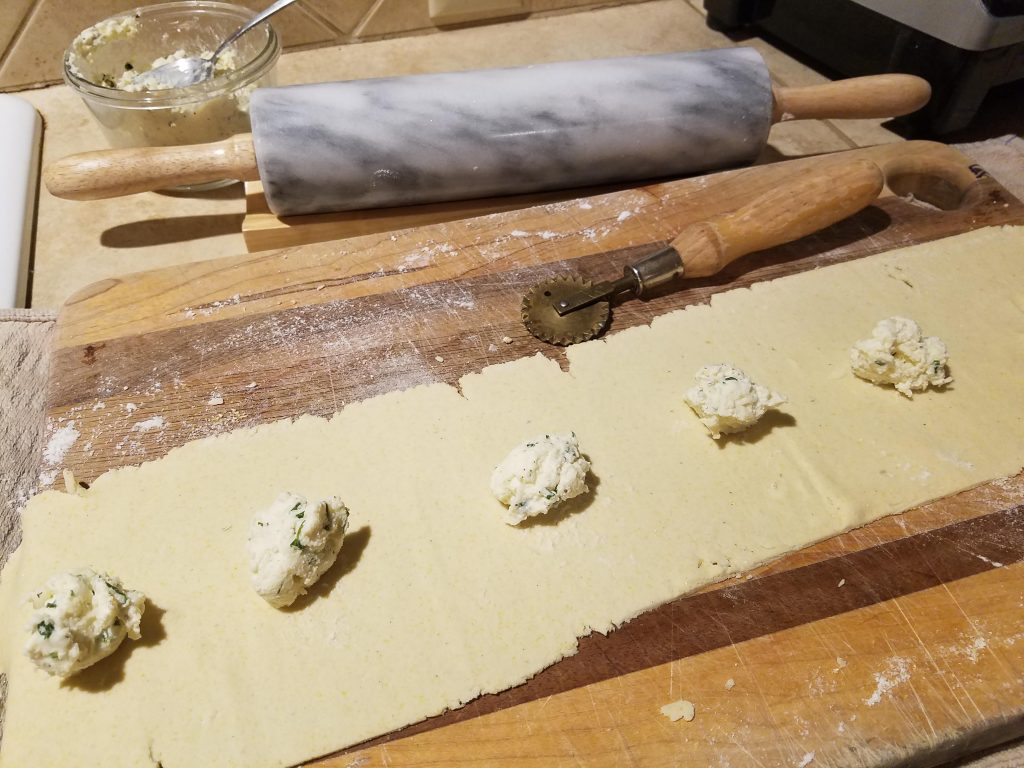
- With your finger, dipped in the egg wash, wet the dough where the seal is going to go around the ravioli. Fold the dough over and use a ravioli cutter (or a pizza cutter and fork to press the edges together). Wet the ravioli with the egg wash very gently and use your flour from the ramekin if you need to do any minor crack repairs, dabbing flour over the egg wash where the crack is. This will keep the filling from leaking out when boiling these.
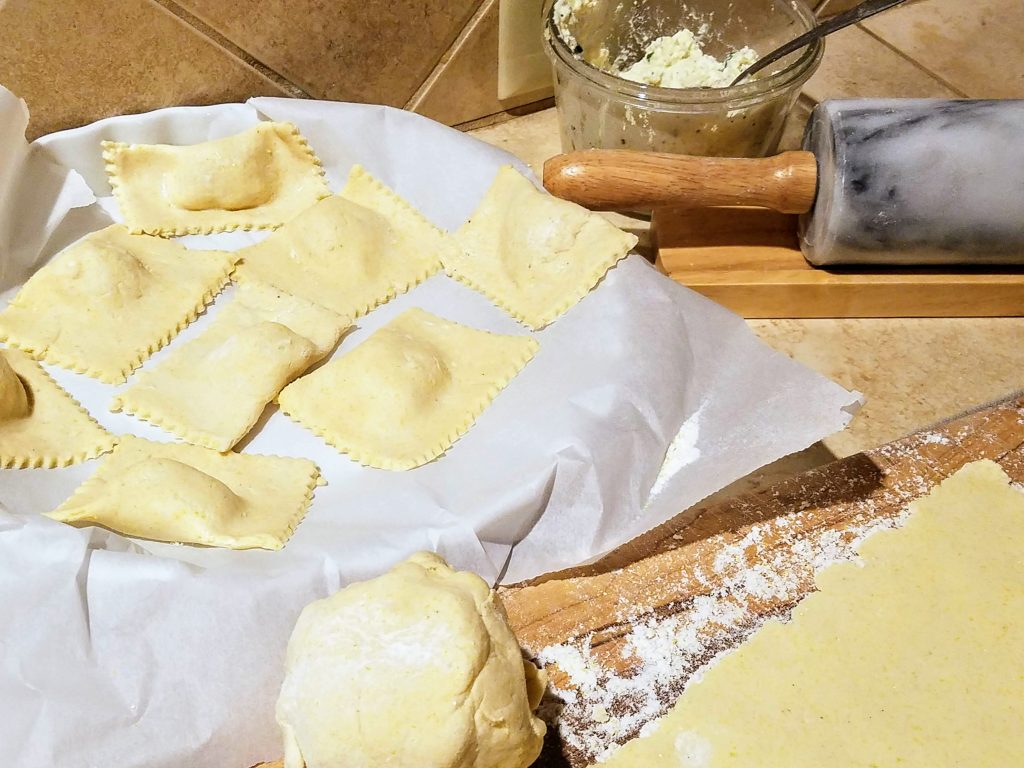
- Method 2: (I prefer this one as it looks prettier to me, and actually may be easier when using gluten free dough which could crack when you fold over). Cut your sheets so they are between 3 1/4 – 3 1/2 inch wide strips and 9 inches long (they should be very close to the same size, but you will cut off the excess). Place a teaspoon of filling at the 1 1/2 inch mark intervals across the sheet. Dip your finger in the egg wash and go around the filling on the dough strips. Lay the other sheet of pasta over the piece with the filling. Smooth the sheets together, pressing around the filling to bring the sheets together. Use a ravioli cutter to cut a straight line across each side of the ravioli line, and then in between the mounds of filling (that you see underneath, making straight lines). Brush with your finger lightly with the egg wash. Fill in any cracks with the flour mixture. Then brush the tops and bottoms with a small amount of egg wash.
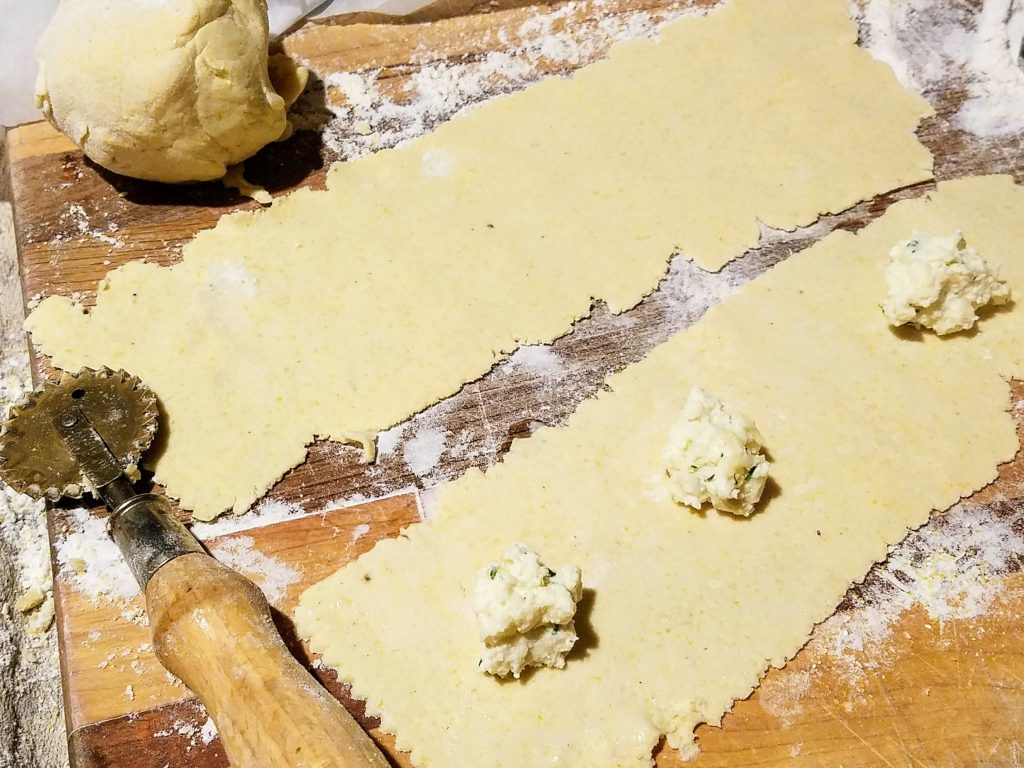
- Move the ravioli to a floured parchment piece. Take any excess dough and lump into another dough ball. Continue with the other pieces of dough in the same way, rolling out a little before sending through the pasta maker several times, then filling the sheets, egg wash where the seal will go, and egg wash the tops and bottom a tiny bit. Continue placing each ravioli on a lightly floured parchment piece, in a single layer if possible.
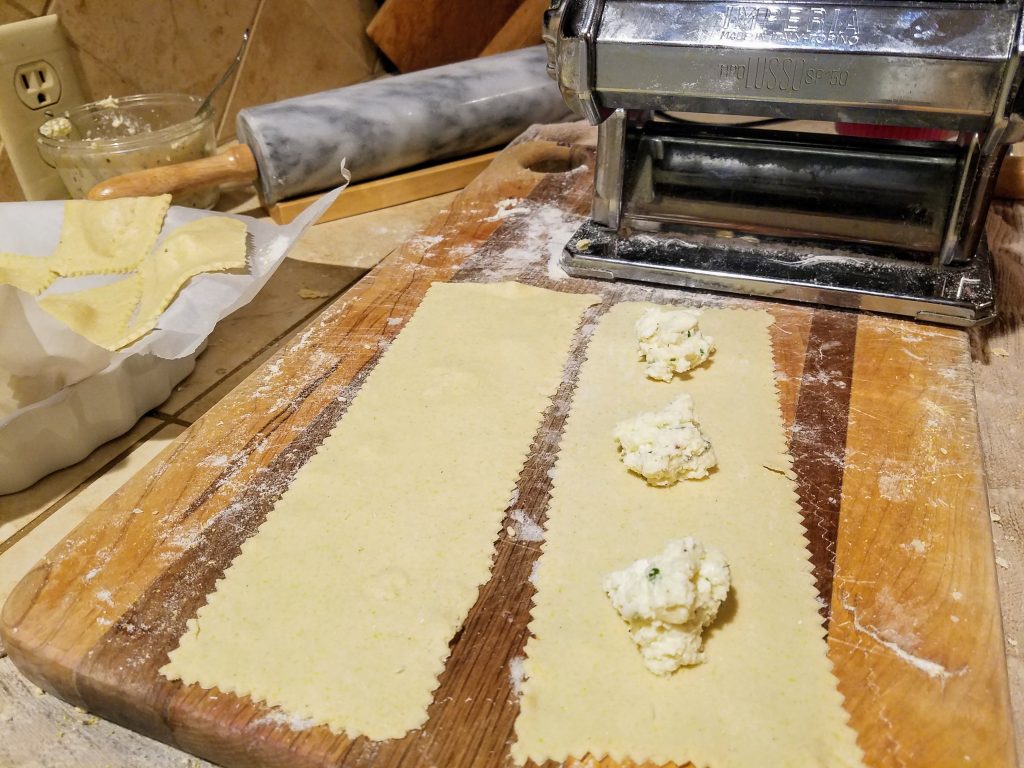
- Just prior to being ready to cook your ravioli, start a large stockpot of water over high heat, with a teaspoon of olive oil and a 1/4 teaspoon of salt. Lower to medium after the water has come to a boil.
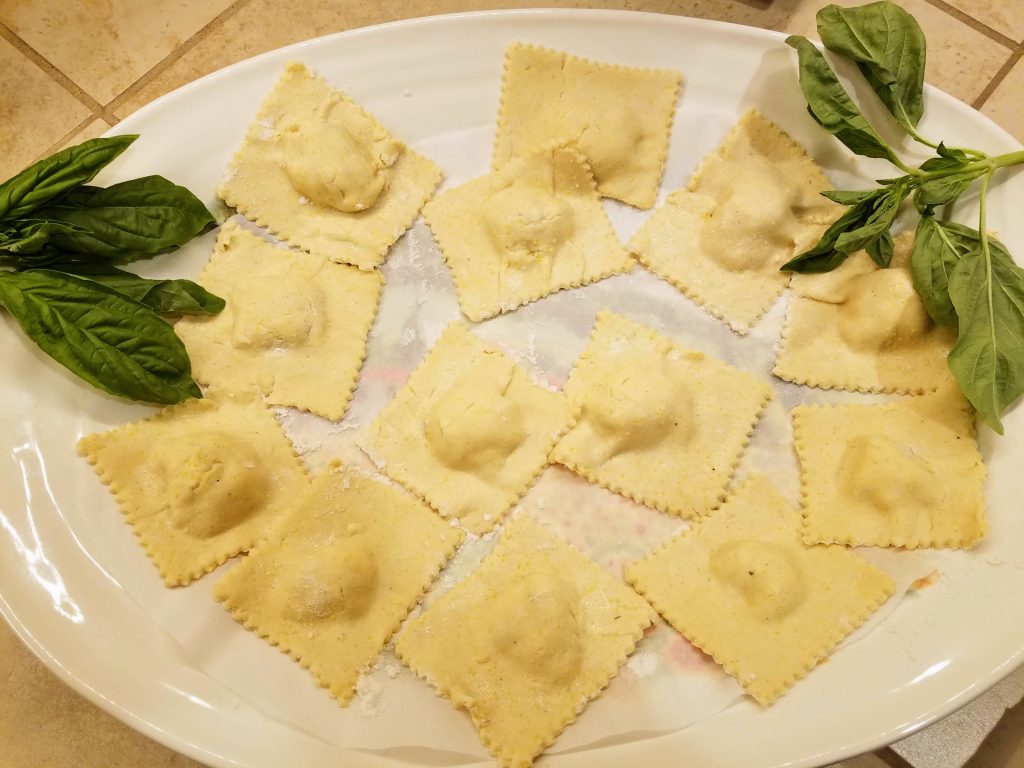
- Drop the ravioli, one by one gently into the stockpot, being sure not to overcrowd them. You might consider cooking in 2 to 3 batches or par cooking them for 2 minutes in 2 or 3 batches. Then add them all back in the water once they have par cooked, for 2- 3 more minutes to finish cooking them, or 4 – 5 minutes total. Remove with a slotted spoon and drain, add a drizzle of olive oil and then spoon of marinara sauce and Pecorino Romano over the family style dish or individual dishes.
Notes
Uncooked ravioli will keep for up to one day refrigerated, between parchment in an airtight container or two days if par cooked. You can also par cook them and freeze in an airtight container between parchment pieces. We par cooked our remaining raviolis and had the following night and they came delicious. Just toss back into a boiling stockpot of water and cook for another 2 – 3 minutes. The sauce is actually even better the following day!